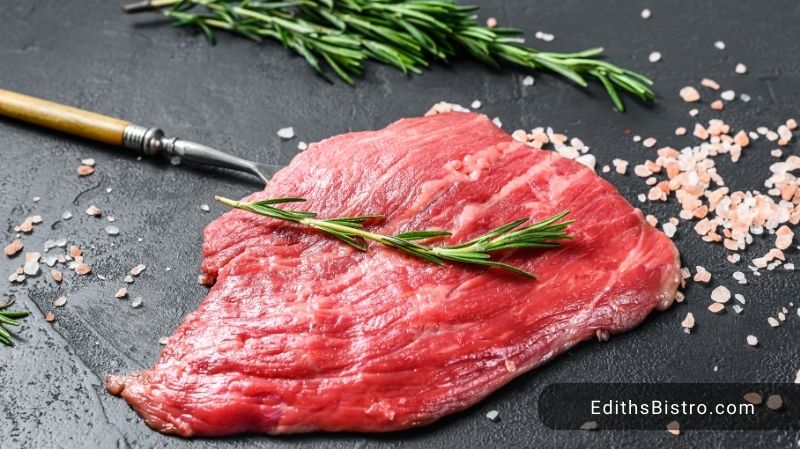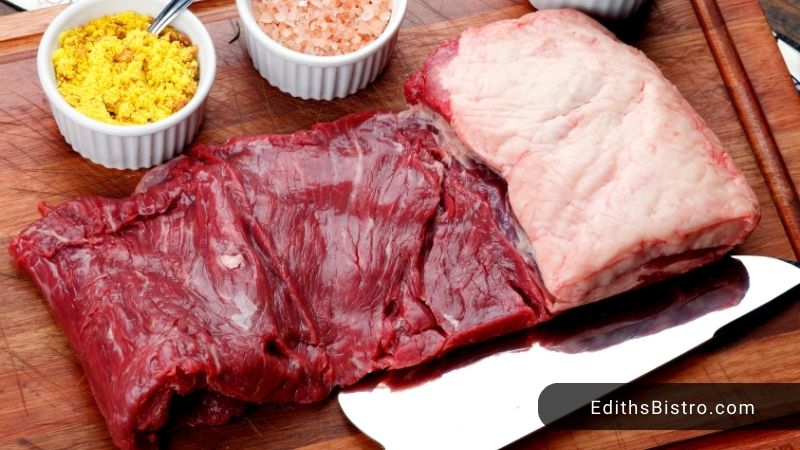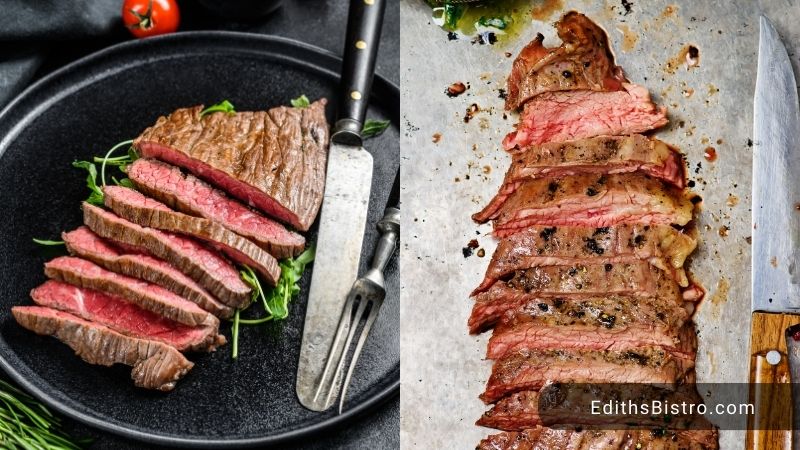While flat iron and flank steak might seem similar at first glance, these cuts offer distinct experiences regarding taste, tenderness, origin, and cooking methods. In this article, let’s explore the key differences between them, helping you make the best choice for your next culinary adventure.
Flat Iron Vs Flank Steak?
The flat iron steak comes from the chuck or shoulder area, specifically the top blade muscle. On the other hand, flank steak is sourced from the lower abdominal region of the cow and boasts an intense beefy flavor, although it is leaner and less naturally tender.
Flat iron steak is known for its exceptional tenderness, fine marbling, rich flavor, and versatility in cooking methods. Meanwhile, flank steak is ideal for dishes emphasizing texture and a bold, beefy taste, such as fajitas and stir-fries.
What is a flat iron?

The flat iron steak, also known as top blade steak, comes from the shoulder of the cow, specifically from the top blade roast or top shoulder. This cut is typically rectangular or elliptical. It also has a uniform thickness.
The flat iron steak originated from efforts to reduce beef waste and boost sales during discounted prices in the 1990s. Research by Dwain Johnson at the University of Florida and Chris Calkins at the University of Nebraska focused on the chuck and round, aiming to create a desirable steak from these more affordable beef parts.
Then, the National Cattlemen’s Beef Association began promoting flat iron steak in 2001.
Pros
- Exceptional tenderness: This flavorful cut is renowned for its tenderness, requiring minimal tenderization.
- Rich flavor: It boasts a robust, beefy flavor with well-distributed marbling, enhancing taste and juiciness.
- Versatility: Suitable for various cooking methods, including grilling, pan-searing, broiling, and roasting.
- Balanced value: It offers a combination of quality and affordability, making it a cost-effective choice.
Cons
- Limited texture variation: While incredibly tender, it may lack the unique texture required for some dishes.
What is a flank steak?

Flank steak is a beef cut from the cow’s lower chest or abdominal muscles. It’s a flat, elongated, relatively thin steak with noticeable grain running across its width. Flank steak is commonly confused with skirt steak, but they are two different cuts of steak (see the comparison between flat iron and skirt steak).
Renowned for its robust beefy flavor, flank steak is popular in culinary dishes like fajitas, stir-fries, and carne asada.
Given its lean composition and pronounced grain, you should marinade flank steak before cooking to tenderize and enhance its taste. When serving flank steak, slicing it thinly against the grain is essential to ensure a more tender and enjoyable eating experience.
Pros
- Bold, beefy flavor: Known for its intense, straightforward beefy taste, making it ideal for dishes where flavor takes center stage.
- Unique texture: Its long muscle fibers and lean composition contribute to a distinctive texture.
- Versatile for specific dishes: Perfect for recipes like fajitas, stir-fries, tacos, and other dishes that benefit from its texture and flavor.
Cons
- Requires marinating: Unlike flat iron, flank steak is tougher and benefits from marinating before cooking.
- Limited applicability: Its specific texture and flavor profile may not be suitable for all dishes.
Key differences between flat iron vs flank steak
Both flat iron and flank steak have unique characteristics and are suitable for different culinary creations. So, choosing between them often depends on the specific dish and flavor profile you desire. Here are the key differences between flat iron and flank steak:
| Characteristics | Flat iron steak | Flank steak |
|---|---|---|
| Cut and location | It is derived from the chuck or shoulder area of the cow, specifically the top blade muscle. This cut is obtained by separating the top blade muscle from its central connective tissue, creating a rectangular or flat-shaped steak. | It comes from the lower abdominal region of the cow, situated near the belly. It is a long, flat, and oblong cut with a grain that runs the length of the steak. |
| Texture and appearance | This steak is renowned for its exceptional tenderness and fine marbling throughout the meat. | It has a lean and fibrous texture. |
| Flavor profile | It offers a rich, beefy flavor with moderate marbling, enhancing its taste. The marbling contributes to juiciness and a well-rounded beefy essence. | This cut of steak is known for its intense beefy flavor but leans toward the lean side. It delivers a robust, straightforward beef taste without the added richness of marbling. |
| Tenderness | Flat iron is considered one of the most tender cuts of beef. It doesn’t require extensive tenderization methods and can be perfected with simple techniques. | While highly flavorful, it’s less naturally tender than flat iron steak. It benefits from marinating before cooking to maximize tenderness and should be sliced against the grain during preparation. |
| Versatility | Flat iron is exceptionally versatile, making it suitable for various cooking methods. It can be grilled, pan-seared, broiled, or cooked in various ways while maintaining its tenderness and flavor. | This steak is often chosen for dishes where its bold, beefy flavor and unique texture shine. Commonly, it’s suitable to use in fajitas, stir-fries, tacos, and other preparations that take advantage of its fibrous structure. |
| Cost | It offers an attractive balance of quality and affordability. This steak is often considered a budget-friendly choice among beef cuts, providing great value. | Flank steak is more affordable than flat iron steak, making it accessible for culinary creations without breaking the bank. |
| Serving size | Due to its size, it generally serves two or more people, making it a favorable choice for larger meals or shared dishes. | It typically serves two people, making it suitable for smaller, more cozy meals. |
Is Flat Iron Or Flank Steak Better?

In short, the better choice between flat iron and flank steaks depends largely on your preferences. If tenderness, versatility, and marbling are your priorities, flat iron steak may be best. This steak does not require any added marination or tenderation.
Conversely, flank steak is an excellent option if you appreciate a pronounced beefy flavor and are cooking dishes that emphasize texture. In addition, flank steak is leaner and healthier, and it is also more suitable for making steak fajitas.
FAQs
Can you substitute flat iron steak for flank steak?
Yes, you can substitute flat iron steak for flank steak in many recipes. In most cases, substituting flat iron steak for flank steak will work well, especially when looking for a tender and flavorful alternative.
Is flat iron or flank steak better for fajitas?
Flank steak is the better option for fajitas. While it’s not as tender as flat iron steak, it has a robust beefy flavor and can be very satisfying in fajitas. The key to using flank steak in fajitas is to slice it thinly against the grain after cooking to maximize tenderness.
References:
- Wikipedia – Flat iron steak – https://en.wikipedia.org/wiki/Flat_iron_steak
- Wikipedia – Flank steak – https://en.wikipedia.org/wiki/Flank_steak






![What To Pair With Quiche? 25+ Best Dishes [With Pictures]](https://www.edithsbistro.com/wp-content/uploads/2024/04/what-to-pair-with-quiche-160x90.jpg)
